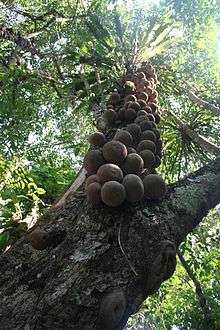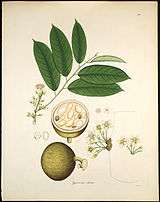Gynocardia odorata
| Gynocardia odorata | |
|---|---|
 | |
| Scientific classification | |
| Kingdom: | Plantae |
| (unranked): | Angiosperms |
| (unranked): | Eudicots |
| (unranked): | Rosids |
| Order: | Malpighiales |
| Family: | Achariaceae |
| Genus: | Gynocardia |
| Species: | G. odorata |
| Binomial name | |
| Gynocardia odorata R.Br.[1] | |
| Synonyms | |
|
Chaulmoogra odorata Roxb. | |
Gynocardia odorata is a species of evergreen tree belonging to the Achariaceae family. The trees grow up to 30 m tall. The species is found in moist forests of mountain valleys in South Asia - India, South-east Xizang and Yunnan in China, Bangladesh, Nepal and Myanmar.

The seeds of this plant have been confused with Hydnocarpus wightiana as the Chaulmoogra oil, which is used in Indian medicine to treat several skin conditions and diseases. During British rule, several British doctors studied the use of this oil in the treatment of Leprosy, Lupus, Scrofula and many skin diseases. The oil was prescribed for Leprosy as a mixture suspended in gum or as an emulsion.[2] However, it has later been clarified that the actual Chaulmoogra referred to in Sanskrit texts for the treatment of Leprosy, as Tuvaraka[3] is actually Hydnocarpus wightiana.[4]
References
- ↑ Roxburgh,Pl. Coromandel. 3: 95. 1820.
- ↑ Cottle, Wyndham (28 June 1879). "Chaulmoogra Oil in Leprosy". The British Medical Journal. 1 (965): 968–969. doi:10.1136/bmj.1.965.968. JSTOR . 25251370 .
- ↑ Sudarshan, S.R. (2005). Encyclopaedia of Indian Medicine: Diseases and their cures. Mumbai: Popular Prakashan. p. 127. ISBN 81-7154-862-8.
- ↑ Buckingham, Jane (2002). Leprosy in Colonial South India: Medicine and Confinement), pp. 91-92. Houndmills, UK: Palgrove. pp. 91–92.